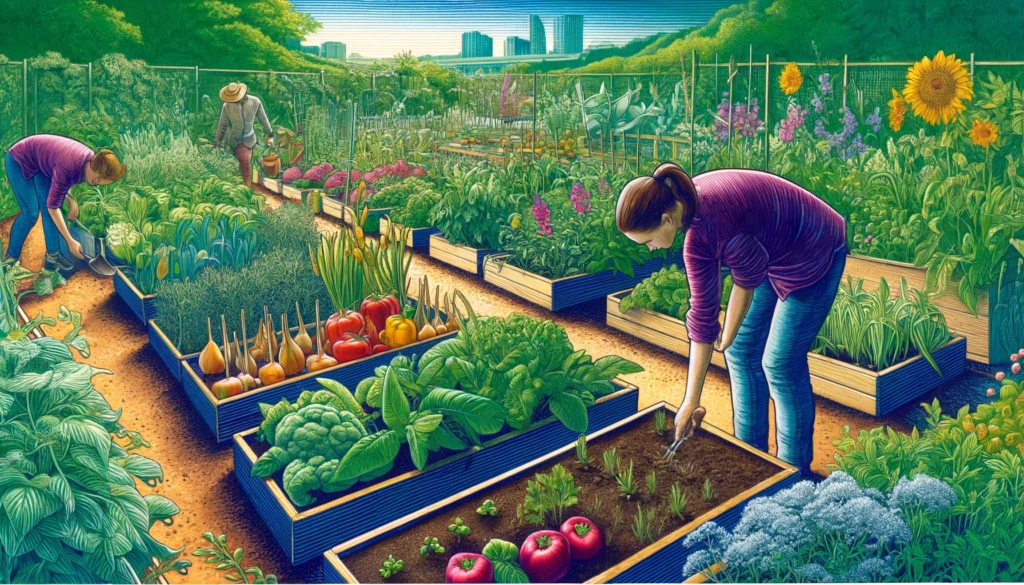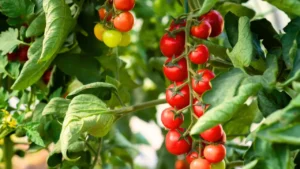
Agriculture Dictionary A vivid and detailed closeup illustration of a community garden. The scene shows a variety of vegetables and herbs growing in raised beds with a pers1.webp.webp
Definition: Community Gardens
Community gardens are shared spaces where individuals or groups come together to grow plants, vegetables, fruits, and flowers. These gardens are typically managed collectively by the community members and can be found in urban, suburban, and rural areas. Community gardens promote social interaction, environmental stewardship, and local food production.
Understanding Community Gardens
Introduction
Community gardens provide a valuable resource for urban and suburban communities by transforming underutilized land into productive green spaces. These gardens foster community engagement, improve food security, and enhance environmental sustainability. They can vary in size and structure, from small plots in vacant lots to large gardens managed by neighborhood associations or non-profit organizations.
Fall off the barn roof and busted your keister? Life on the farm or ranch can be tough on the bum. Need a break? Laugh it off at FarmerCowboy.com, the #1 farm humor site. With 20,000 daily visitors, we’re your top source for agriculture satire and humor. Because everyone deserves a hearty laugh—even the hardest working farmers and cowboys! Join us and turn those long days into fun tales at FarmerCowboy.com.
Benefits of Community Gardens
1. Enhancing Food Security
Community gardens increase access to fresh, locally grown produce, reducing the reliance on commercial food sources and improving food security for participants.
2. Promoting Physical and Mental Health
Gardening activities promote physical exercise, reduce stress, and improve mental well-being. The social interaction and outdoor activity associated with community gardening can enhance overall health.
3. Strengthening Community Bonds
Community gardens bring people together, fostering social interaction and cooperation. They provide a space for community members to connect, share knowledge, and work towards common goals.
4. Improving Environmental Quality
Community gardens contribute to environmental sustainability by promoting green spaces, enhancing biodiversity, and reducing urban heat islands. They also support sustainable practices such as composting and organic farming.
5. Educational Opportunities
Community gardens serve as living classrooms, offering educational opportunities about horticulture, nutrition, and sustainability. Schools, youth groups, and community organizations often use these gardens for hands-on learning experiences.
Types of Community Gardens
1. Neighborhood Gardens
These gardens are typically located in urban or suburban areas and are managed by local residents. Plots are often allocated to individuals or families who are responsible for their own section of the garden.
2. Institutional Gardens
Managed by schools, hospitals, or community centers, these gardens serve specific groups of people and are often used for educational purposes or therapeutic activities.
3. Allotment Gardens
Allotment gardens provide individual plots of land that can be rented or allocated to community members. Each gardener is responsible for their own plot, but the overall garden is managed collectively.
4. Youth and Educational Gardens
These gardens are designed specifically for educational purposes, engaging children and young people in gardening activities and teaching them about food production and environmental stewardship.
Challenges of Community Gardens
Land Access
Securing land for community gardens can be challenging, particularly in densely populated urban areas. Long-term access to land is essential for the sustainability of community gardens.
Funding and Resources
Community gardens often rely on grants, donations, and volunteer labor. Securing adequate funding and resources for tools, seeds, soil, and infrastructure can be a significant challenge.
Maintenance and Management
Maintaining a community garden requires ongoing effort and coordination. Effective management practices and active community involvement are crucial for the garden’s success.
Water Access
Reliable access to water is essential for community gardens. Installing and maintaining irrigation systems can be costly, and water usage regulations may present additional challenges.
Steps to Create a Successful Community Garden
1. Organize a Group
Form a group of interested community members to plan and manage the garden. Establish clear roles and responsibilities to ensure effective coordination.
2. Secure Land
Identify potential sites for the garden and secure permission from the landowner. Ensure that the land is accessible, safe, and suitable for gardening.
3. Plan the Garden Layout
Design the garden layout, including individual plots, communal areas, pathways, and water access points. Consider factors such as sunlight, soil quality, and accessibility.
4. Gather Resources
Obtain the necessary resources, including tools, seeds, soil, and compost. Seek funding through grants, donations, and community fundraising efforts.
5. Establish Rules and Guidelines
Develop rules and guidelines for garden use, including plot assignments, maintenance responsibilities, and community activities. Ensure that these rules are clear and accessible to all participants.
6. Engage the Community
Promote the garden within the community to attract participants and volunteers. Host events, workshops, and meetings to foster community involvement and education.
Case Studies of Community Garden Success
1. The People’s Garden (Washington, D.C., USA)
Located on the grounds of the U.S. Department of Agriculture, The People’s Garden is a model of urban agriculture. It provides fresh produce to local food banks, educates the public about gardening, and promotes sustainable practices.
2. Todmorden’s Incredible Edible (Todmorden, UK)
Incredible Edible is a community-led initiative that transformed public spaces in Todmorden into edible gardens. The project has increased access to fresh food, fostered community spirit, and inspired similar initiatives worldwide.
3. The Edible Schoolyard (Berkeley, California, USA)
The Edible Schoolyard is a school garden program that integrates gardening and cooking into the school curriculum. It provides students with hands-on learning experiences and promotes healthy eating habits.
Conclusion
Community gardens offer numerous benefits, including enhanced food security, improved physical and mental health, strengthened community bonds, and environmental sustainability. By transforming underutilized land into productive green spaces, community gardens contribute to the well-being of individuals and communities. Understanding the benefits, challenges, and best practices for creating community gardens can help organizers and participants successfully establish and maintain these valuable spaces.
How Knowledge of Community Gardens Can Help Urban Farmers
Understanding community gardens, including their benefits, types, and challenges, can help urban farmers make informed decisions and adopt best practices. Knowledge of garden planning, resource management, and community engagement can empower urban farmers to create productive and sustainable community gardens. This knowledge is crucial for building resilient and green urban environments.







Originally posted 2024-05-28 09:54:26.
Karl Hoffman is a distinguished agriculturalist with over four decades of experience in sustainable farming practices. He holds a Ph.D. in Agronomy from Cornell University and has made significant contributions as a professor at Iowa State University. Hoffman’s groundbreaking research on integrated pest management and soil health has revolutionized modern agriculture. As a respected farm journalist, his column “Field Notes with Karl Hoffman” and his blog “The Modern Farmer” provide insightful, practical advice to a global audience. Hoffman’s work with the USDA and the United Nations FAO has enhanced food security worldwide. His awards include the USDA’s Distinguished Service Award and the World Food Prize, reflecting his profound impact on agriculture and sustainability.






